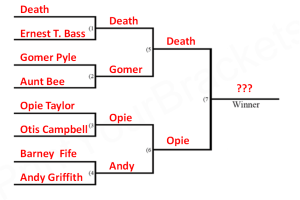But if it is preached that Christ has been raised from the dead, how can some of you say that there is no resurrection of the dead? (1 Corinthians 15:12)
At the end of regulation, the sun sank toward the horizon late on Good Friday. Three mangled bodies hung limply on a trio of crosses outside Jerusalem. Shattered bones protruded from crushed legs of the first and third victims. The second man suffered no broken bones in his sufferings, though a waterish liquid dripped from a fresh spear wound in his side. All three men were dead. There was no longer any doubt about that. Their cooling bodies were removed from the crosses and carried out of sight.
Because local religious leaders filed a protest, game officials decided the Tournament of Life would have to extend into overtime. They posted a guard at the tomb of the second man to ensure that Death would remain victor.
But they were working with an incomplete rule-book. Here are three rules they didn’t understand. To be fair, we struggle to understand the rules of the game of life, too.
1) The game officials on Good Friday understood how life preceded death, but they didn’t understand how death preceded life. They thought death was the end of the game. To the contrary, their own Scriptures taught death as separation of the spirit/soul from the body, not annihilation. When a personal dies, their spirit/soul continues to live. Furthermore, life could could be restored to a dead body. Historical figures as far back as Abraham understood God could raise the dead. The Apostle Paul later wrote to the Ephesian believers that they had been dead in their transgressions and sins (Ephesians 2:1). But they were no longer dead. They had been made alive in spirit. Scriptures demonstrate both a resurrection of the body and a resurrection of the soul/spirit.
2) The game officials on Good Friday understood that everyone is mortal, but they didn’t understand what happens after death. If death is not the end, something else must come next. “Sheol” is a Hebrew word used to describe the grave in the Old Testament. “Paradise” is a word with roots in both Hebrew and Greek. It occurs three times in the Old Testament and three times in the New Testament. When I was in graduate school, a professor taught us that paradise was a subset of Sheol (the grave), a place set aside for the righteous who are awaiting resurrection. Modern scholarship isn’t so sure. Some scholars believe it refers to the abode of God, that is, heaven. “Paradise” also appears to refer to a garden. The Septuagint used it to describe the Garden of Eden in Genesis 2 & 3. “Paradise” appears in Revelation 2:7, which also is a garden scene.
“Paradise” describes the idyllic world before sin entered (Genesis 2). It describes the redeemed world after sin is eradicated (Revelation 2). It describes the abode of the righteous dead (heaven or the grave). It describes the destiny of the man on the third cross because of the man on the second cross (Luke 23:43). Their bodies were both in the grave, so paradise in this context is a temporary environment, either a cold grave awaiting resurrection or a bright heaven in the presence of God.
3) The game officials on Good Friday understood how the wages of sin is death, illustrated by the sacrificial system, but they didn’t understand how atonement could satisfy God’s righteous judgment of sin (Isaiah 53:11). God’s just satisfaction was demonstrated when he raised Jesus from the dead on Easter morning. God the Father not only raised Jesus to bodily life, he promises eternal life to those who belong to Jesus. Followers of Jesus die to sin on the third cross, a death which leads to eternal life. Jesus said, “Because I live, you also will live” (John 14:19).
Because of the resurrection of Jesus on Easter, the Apostle Paul declared him the winner of the Tournament of Life: When the perishable has been clothed with the imperishable, and the mortal with immortality, then the saying that is written will come true: “Death has been swallowed up in victory.” (1 Corinthians 15:54).
He is risen! Death is defeated! Hallelujah!
Happy Easter!

